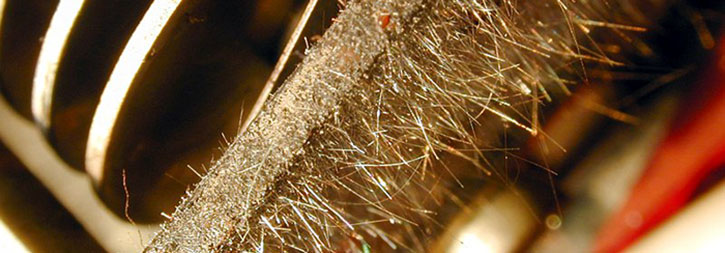New Theory Explains Mysterious Growth of Metal Strands

(Inside Science) -- They're but a wisp of metal, hardly noticeable to the human eye. Yet they've crippled everything from pacemakers and watches to missile systems and satellites.
Although these seemingly innocuous metal strands, which appear in electronics, have been wreaking havoc for more than 60 years, no one knows exactly how they form.
But one physicist now says he may have an idea. If he's right, his theory could lead to a better way to prevent such damage, which he says has been estimated to cost billions of dollars.
These strands, called whiskers, were discovered when they disabled aircraft radios during World War II. They sprout from what were once smooth surfaces of metals like tin, zinc, and cadmium, and when they grow in electronics, the strands can touch nearby electrical components and trigger short circuits. Although they are usually less than a millimeter long, they have been known to reach 10 millimeters.
Whiskers, which are ten to a hundred times thinner than human hair, have been blamed for a myriad of electrical failures. Most recently, they were implicated as a possible cause of the sudden, unintended acceleration of Toyota vehicles. In 2011, however, a NASA Engineering and Safety Center report for the National Highway Traffic Safety Administration could not demonstrate that tin whiskers were the culprits of high-speed accelerations and brake failures.
Citing the report, Toyota has said whiskers were not responsible. But the strands, which were found in defective accelerator pedals, aren't completely exonerated, said Henning Leidecker, a physicist at NASA's Goddard Space Flight Center in Greenbelt, Maryland, who was a part of the investigation of unintended acceleration. In fact, he said, the report found that whiskers triggered slower-speed accelerations that reached 20 to 35 mph, although the brakes were able to reduce the speed.
To mitigate the damage brought on by whiskers, engineers have tried special coatings that stunt whisker growth or avoiding the most susceptible metals altogether. "People don’t really understand why they grow," said Victor Karpov of the University of Toledo in Ohio. "They don't know how to universally beat them."
Sign up for the Live Science daily newsletter now
Get the world’s most fascinating discoveries delivered straight to your inbox.
Previously, researchers suspect that stress on the metal creates the whiskers, Karpov said. But there was no real explanation for why this should happen.
Now Karpov said he has what may be a better theory. According to his idea, which he published last week in the journal Physical Review Applied, whiskers do not sprout directly from mechanical stress, but from electric fields created by the metal itself.
Stress or defects can produce patches of positive and negative electric charges on the metal's surface, Karpov explained. Each patch generates an electric field that repels anything with the same charge. And since the patch is filled with bits of metal of the same charge, some of that metal is expelled, shooting out in the form of a needle-like strand.
"This is the first time this mechanism has been proposed as far as I know," said Leidecker, who wasn't a part of Karpov's work. "It's a mechanism that's consistent with the laws of physics. I don't know of a physical reason against it, so I think it's worth exploring."
While more work remains to further test, develop, and refine the theory, it does make several predictions, Karpov said. For one, the theory predicts that a whisker would first grow slowly, but after about a month or so, it would sprout very quickly — which is exactly what happens in reality. The theory is also consistent with the fact that a variety of factors ranging from stress to contaminants in the metal can lead to whisker growth.
Karpov admitted that many questions remain. For example, his theory can't yet describe whisker growth down to the detail of individual metal grains. And, as Leidecker pointed out, it doesn't explain why some metals are prone to more whiskers than others.
To test the theory, Karpov plans to grow whiskers in a strong electric field, which should greatly affect how they grow. One experiment won't be convincing enough, but if the theory ultimately proves correct, then it could be a boon for preventing whisker damage.
"If I'm right, and there are random charges sitting on the metal surface, there might be a way to neutralize them," Karpov said. One way to neutralize the charges is to spray the metal with a liquid that contains positively and negatively charged nanoparticles. The nanoparticles would be attracted to the oppositely charged patches and neutralize them — and nip the whiskers in the bud.
This story was provided by Inside Science News Service. Marcus Woo is a freelance science writer based in the San Francisco Bay Area who has written for National Geographic News, New Scientist, and other outlets.










